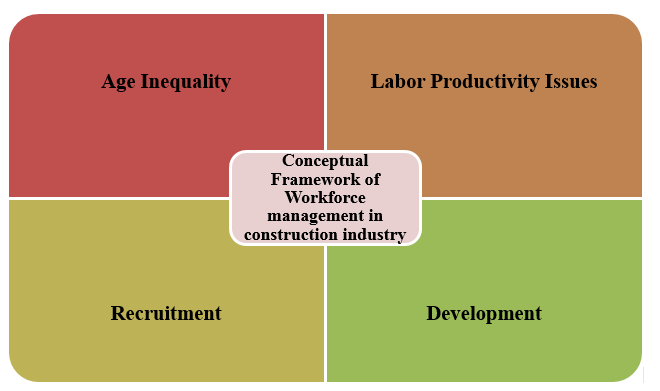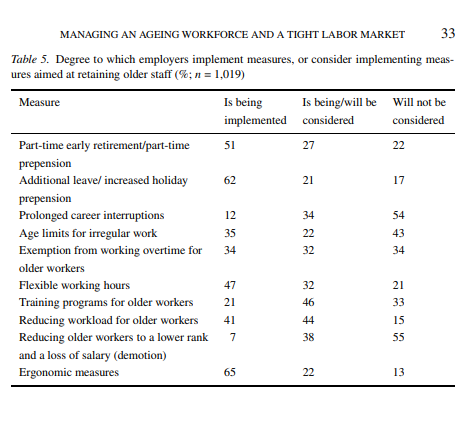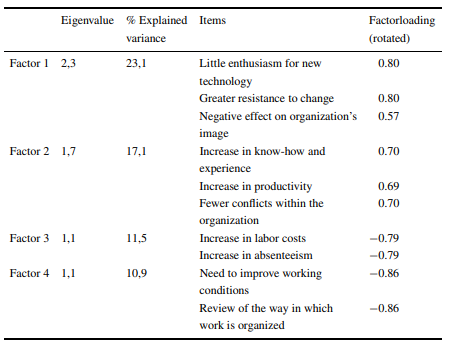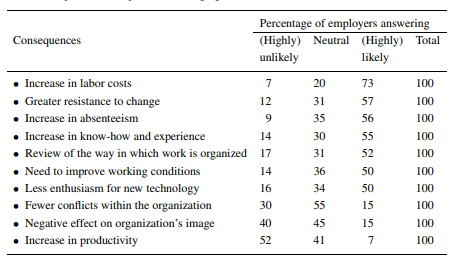BUSN20019 Professional Project Assignment Help
Managing Ageing Workforce in the Construction Industry
Write a reserach project on Managing Ageing Workforce in the Construction Industry.
Dont miss your chance to excel in assignments! Hire tutor of Expertsminds.com for perfectly written BUSN20019 Professional Project Assignment Help solutions!
The study reviews the aged workforce management literature in the construction industry. The CIOB (Chartered Institute of building) is the chief professional organization for managers in the overall building or construction industry. The organization was established in 1834 to guide the system for promoting, establishing and maintaining principles or quality standards in the construction industry. An extensive series of professional disciplines has been proposed by the organization for construction and building industry managers. The study is to explore the effects of the elderly workforce, working the building or construction industry. The study investigates the general issue of the ageing population in the construction industry, age awareness, and the best way to move towards the solution of this challenge.
Problem statement
Age inequality in employment is a major issue for the construction industry. The building and construction work is mostly fieldwork and it demands a considerable amount of physical labour. In this situation, more number of aged workforce, who have less physical strength as compared to the young labours, decreases the productivity. The main problem is not having a proper retirement age for workers in construction industry.
Research Aim and Research Question
The aim of the study is to investigate a management plan for the elderly workforce in the building or building industry. Meaning of aged population is the number of people who are old and does not have enough physical capacity as compared to the youth. Therefore, the demographic characteristic of the country is not in a balanced form. As the jobs in construction industries are very physically tiring, it is not safe to extend the age of retirement for workers of the industry. The research is to raise awareness about the matter. Some research questions that might come up are-
- What are the problems of the ageing workforce more than other groups of age in the building and construction industry?
- Why the ageing workforce is increasing in the construction industry?
- What are the solutions to manage or solve the problem?
Conceptual framework
Age inequality in employment
Age inequality in employment is a major issue for the construction industry. Construction industries need to ensure a comprehensive environment and a safe workplace for the employees. If the demographic characteristics of a nation are not balanced, it is not good for economic development (Goh, et al., 2016). Then this issue will become a problem among a different sector of the economy. The construction industry needs a physically strong workforce to work on the construction site. If the ratio of above 60 age group and other age group is not balanced then the outcome may not be satisfactory for the growth of the economy of the organization(Lyu, et al., 2018). The aged population may be experienced or may be mature; however, the population's workability may not be sufficient for the construction industry. The age of retirement is not proper for the development of the industry, because if the age of retirement more than new vacancies cannot be created. New vacancies are very necessary for the growth of the industry(Chan, et al., 2016).
Labor productivity issues
The construction industry is losing a valuable resource for this social problem. The imbalanced age pyramid is an alarming situation of a nation. This circumstance is generating problems for the economic growth of a country as well as for the construction industry (Ksiazek, & Nowak, 2017). The construction industry is one of them, whichare facing problems due to the aged population. The ageing population is not efficient enough to work in construction sites, because this is a safety issue. The construction industry is facing problems due to lack of new recruitment and less young employees (Ng& Chan, 2015). The new employees have more productivity than aged workers do. Therefore, the industry-aged workforce has been creating problems in the productivity of the industry.
Recruitment and promotion:
The recruitment of new skilled employees is the key aspect for the growth and maintaining the quality of the industry (Pan, Chen& Zhan, 2018). Young and skilled employees are necessary for the growth in the productivity and turnover for an industry. Replacement of aged employees with young employees is necessary to multiply productivity. The replacement process needs to be done on a regular basis because the new employees need proper training to provide quality work (Choi, 2015). The aged population is experienced; therefore, the aged workers need to transfer their knowledge gathered by their experience to the new employees, to make them resourceful in work.

Fig 1- Conceptual Framework of Workforce Management in Construction Industry (Source- Self-made)
Literature review
Introduction
The literature review will offer a closure and better outlook on the subject of managing ageing workforce by opting two different theories on the subject. The theories, the literature review will discuss is based on the issues of ageing workforce and the causes of it whereas second theory is to solve the issue by opting sustainability for reputation which ultimate is done by increasing profit margin which will offer a better scope to employ young efficient people. The research will discuss the theories by citing journals from past and present context for covering wide area. The paper will further find out the gaps of the literature and finally will offer a recommendation for it. The literature review even contains a precise summary in it.
Disabled aged workforce:
A construction agency strongly depends on its workforce who needs to be very strong and efficient to go for a smooth and long run.However, according to Remerry et al (2003) the most of the construction agencies are fully filled by the disabled and aged people who cannot be able to do the work properly for their disability. Author shares the view that the issue of ageing workforce mainly revolves around some issues as one problem is disabled people and another is the low participation of workforce. The disability happens in the construction agencies during the work in the workplace. Thereby, the agency cannot able to move them completely but suffers from the issue of proper labor force. The middle-aged people are not sufficient for doing the work thus the work process is suffered. All these people even suffer from the health care issues as all these people are having sensitive issues through the health care sector.
According to Rahman et al (2015), recent reports and statistics disclose the fact that most of the workforces in the construction agencies are mostly grasping with the aged people. The physical capability used to get reduced with the ages but their job role do not change in the construction agency which enhance the risk factors in the workforce by engaging them in Manual Handling (MH) and often serves as serious issues regarding safety factors. Thereby it needs to identify the safety issues in the construction agencies and eliminating the sources of such risks. To manage this ageing workforce issue age friendly job can be a better option where the role or duty of the employee will be changed by his ages. Thus, the construction agencies can mitigate the risk factors and can able to solve the issue of ageing workforce. By go with the strategy the construction companies even able to get a better profit margin with reputation.
Reputation and sustainability disclosure:
According to Michelon (2011), depending on legitimacy theory, reputation of a company depends on sustainability disclosure. Author justifies three dimensions regarding ideology of reputation, which consists of financial performances, commitment towards stakeholders along with media exposure. Companies which produce adequate financial performance by adopting spontaneous strategic standards towards stakeholders and are done by immense public pressure, and there, the companies communicate through their legitimacy to connect with the stakeholders. Analyzing of corporate reports even proves the fact that environmental and social contents used in international sample offers the companies to compare disclosure practices in European companies. Thereby media exposure and commitment towards stakeholders are strongly connected with sustainability disclosure, which varies depending on different information. Without one of these two or improper connection between these two will not be able to serve the purpose of sustainability disclosure.
According to Alon et al (2015), the impact of sustainability report on company's reputation though well versed still needs to be examined further. The outcome or impact will be judged by putting legitimacy along with signaling perspectives to assure if the said two factors really share any correlation between these two. Top companies often go for external assurance regarding sustainability disclosure, though reputation cannot be affected by assurance directly. Assurance being a managerial tool closely connected with the congruence regarding internal processes but not completely different signaling for the stakeholders.
According to Sroufe et al., (2018), there is a strong relationship between financial performance and social responsibility. Though to get its success one needs to understand the innovative process opted by the companies, with doing a tie of theories for practice. The practical experience by doing a survey in reputed firms proves the facts that a strong relationship can be generated among the sustainability practices, sustainability performances and financial performances of companies. This even can able to measure the performance by sustainable reports by samples regarding cross sectors.
Thus, by offering sustainability in the sector, the construction company will be able to gain more profit by their reputation and by which they will be able to remove the issue of ageing workforce for the company as reputation and high profit margin will give them the scope to higher efficient and proper workers.
Gaps
The literature shares a gap in the literature as it contains the issue of ageing workforce with its causes but it fails to offer some remedies to solve it where it can offer only one strategy for the issue, which is not enough for resolving the issue. The second gap it throws as sustainability and reputation is not directly connected with the ageing workforce but it connects with these in a way to resolve the issue by gaining reputation through the increased profit margin. The discussion over sustainability and reputation offers two different views on the same topic related to reputation and sustainability disclosure. In the same topic two authors are of the view that reputation and sustainability disclosure are closely connected with each other and complementary whereas one author is not agreeing with the fact as he of the view that the effect of sustainability on reputation is questionable and yet to prove. Whereas, the connection between sustainability and ageing workforce is not directly connected with each other. Rather the issue is indirectly motivated by the factor of reputation and sustainability of a company.
Summary
The literature review discusses with the subject managing ageing workforce by opting two far different theories for the topic. The discussed first theory is the issue of ageing workforce is caused by the disabled aged, and weak people with a remedy to solve the issue by offering age friendly job. The second theory rather offers a better remedy to manage ageing workforce by the connection between sustainability and reputation as reputation of a company gives it better scope for employ efficient people.
Methodology
Data collection
The method of the study is qualitative. The approach of the research is positivism, based on observation the concept of the research evaluated. The study is a constructive study; the issue of aged population management in the construction business is a social phenomenon. This social phenomenon can be measured based on theoretical assumption. Based on secondary data, the research work has been evaluated. The paper includes the contemporary knowledge, methodological and academic contribution to the topic. The selected literatures are relevant and a proficient quality of evidence to that research questions. The paper produces a consistent result on this topic.
Data analysis
The research question and objectives have a reality in the social order. The objectives of the study are very contemporary in different countries. A hypothesis is not necessary for this study. A description of the management method of ageing workers in the construction business is briefly discussed in this study. There are mainly qualitative kinds of literature to review. The survey report is a descriptive and qualitative report. The report can be helpful for future research work. The applied method is an appropriate method to be used in this study. Though there are, few limitations in this method as if the secondary data is may not be appropriate for the study.

Finding and Analysis

Table 1: Degree to which employers implement measures, or consider implementing measures aimed at retaining older staff (%; n = 1,019)
(Source: Remery, Henkens, Schippers & Ekamper 2003 p- 21)

Table 2: Results of factor analyses (with oblimin rotation) of consequences of an aging workforce for the organization.
(Source: Remery, Henkens, Schippers & Ekamper 2003 p- 21)

Table 3: Expected consequences of an aging workforce (%; n = 1,019) (Source: Remery, Henkens, Schippers & Ekamper 2003 p- 21)

Table 4: Organizations decomposed by percentage of older workers and by sector (in %; N = 1,007)
(Source: Remery, Henkens, Schippers & Ekamper 2003 p- 21)
The construction industry is facing a problem of huge number of aged workers in comparisons to younger employees. There are a lot of vacancies in this field compared to the available workforce in the country (Kurtzer, 2018). According to different research work, there are different findings. Some author focused on the reputation and sustainability issue found in the management of aged workers. Some authors focused on economic impacts on construction industries. It is very important to maintain the progress of work and development of the industry. Development is possible only by increasing the productivity of the workers. Sustainable development can be maintained by the maintaining the quality of work. This is also important to maintain the reputation of an industry (Loganathan, et al., 2017). New employees have the potential and ability to work on the construction site. As the construction industry demands physical strength to work on the site, the aged people are not suitable to work with efficiency (Jennings, Nagarathnam& Lawrence, 2018).
Discussion
H1 issue of ageing workforce
According to the literature review, the first hypothesis presented in the paper is about the issue of ageing workforce as the workforce in the construction industries are filled with aged and disabled workforce who create problem for the company, as they are physically not competent for the workforce but cannot be terminated altogether.
H 2 remedy for the issue
The second hypothesis presents a remedy for the issue as this ageing problem creates problems from the company and apparently it does not provide any direct solution thereby by putting sustainable workforce in the production the company can earn profit and reputation by which they will be able to hire more skilled, efficient and young professionals for the workforce and thus can be able to avoid the problem.
Conclusion
This section of the study address the research questions, point out the limitation and providing some recommendation.
Addressing aim and research question
The construction industry needs a huge number of younger workers. The work is mainly conducted on the construction site. which is the reason for the demand of high physical fitness. That is why the aged population is not suitable to work in a construction site. If the industry has a huge number of aged workers then the industry needs to look after this matter to maintain the development process of the industry. The construction industry needs to continue the replacement process. The replacement processes of workers are needed to be done by sustainable method (Sullivan, et al., 2017).
The skilled workers transfer their knowledge and share their experience with the new employees to make them efficient. Therefore, the industry needs to maintain the balance between the different groups of workers. The industry needs to survey the field on a regular basis for managing the employees and works. The construction industry needs to organize sufficient safety equipments and methods for the aged workers. The extension of the age of retirement is not favorable for managing the problem; therefore the construction industry needs to maintain the rule of the age of retirement (Chang-Richards, et as., 2015).
Limitation
There are the following limitations on the management process of aged population in the construction industry.
- The aged workers are experienced and skilled. If there are a huge number of employees who are going to be retired in few years or months, then the industry will lose a huge number of skilled workers. The industry needs to recruit new employees on the position.
- There is a main limitation to recruit new employees. The limitation is the social demographic condition. If the aged population (60 above) is greater than the young population (age between 16 to 50) then the industry will not be able to get enough number of employees in the vacant positions. The government legislation is responsible for improving that kind of demographic situation.
- Another limitation is absence of technical knowledge among young workers. Fast development in economy of a country increases the number of construction industries. The construction industry is mainly dependent on educated and efficient workers. However, due to lack of skilled workers, the industry is not able to get a sufficient number of workers from nearby places. In this situation, the industry is forced to hire efficient workers from other countries. Then the expenses of the industry increase (Ayegba& Agbo, 2015). The social structure is responsible for this kind of situation.
These are the three major limitations in management of ageing workforce in the construction industry.
Recommendation
The report is intended for construction industries. Age management is the main aspect of this survey. The older workforce is the main factor of concern. This sector of the industry is facing the age management issue. This study might be helpful for future assessments. After the research work, it can be concluded that the issue needs to investigate and proper resolutions need to be taken. There are some limitations to this topic. Proper recommendations have been suggested in the report. The age management issue may not be addressed by the institution itself, as the situation can be developed by different factors. The age management in the construction industry is an essential issue to concern about. Industries are the main economic background of a country. The construction industry needs to make a sustainable plan to manage the number of older workers. The industry needs to put hard work to address the factors associated with aged construction workers. A physical condition and security plan is needed for older employees, to manage the issue.
There are some recommendations for managers and for the country.
1. Increase the attentiveness of the challenges faced by the ageing population.
2. Promotes surveys, researches, reports and innovation.
3. Encourage young population to invest their future in the construction industries.
4. Make educated people in the course of professional learning.
5. Encourage the continuous personal development.
These recommendations are could be helpful for administration the ageing labor force in the construction business.
Are you looking for reliable BUSN20019 Professional Project Assignment Help services? Expertsminds.com is right choice as your study partner!
Get the best Central Queensland University Assignment Help services for its academics units and courses such as:-
- BUSN11015 Applied Business Research Assignment Help
- BUSN13004 Professional Business Practice and Experience Assignment Help
- BUSN11016 Introduction to Professional Business Practice Assignment Help
- BUSN13002 Advanced Social Innovation Assignment Help
- BUSN13001 Research Fundamentals Assignment Help
- BUSN12001 Business Internship Assignment Help
- BUSN13003 Pitching and Funding of Innovations Assignment Help
- BUSN12002 Professional Business Practice and Experience Assignment Help